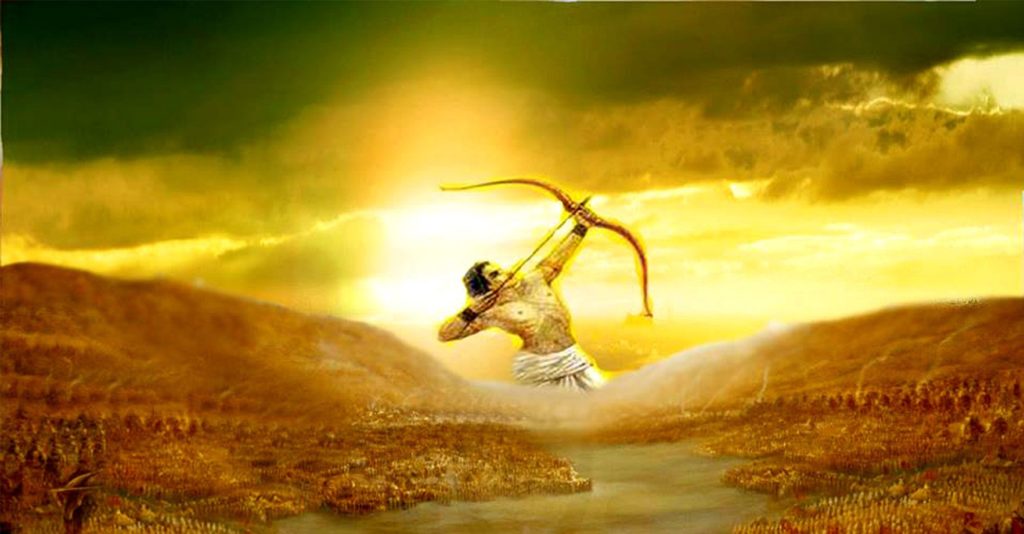
Dalit History Month – Eklavya and the Adivasi-Dalit Rejection of Brahminism
The myth of Eklavya is taken by many in the Adivasi and Dalit communities as an example of the social havoc Brahminism attempts to wreak. In the Mahabarata, Eklavya is written as a tribal (Nishada) boy who was keen on learning archery. To forward his goal, he approached the great archery teacher of his time, Dronacharya, and asked to learn with him. Dronacharya, on learning Eklavya to be a “low” Caste tribal, refuses him immediately. Dismayed but not deterred, Eklavya fashions an image of Dronacharya out of clay and practices before it. Years later, their paths meet again and Dronacharya is both impressed and threatened by the boy’s incredible talent as an archer. He fears that his own top pupil, Arjuna (a Kshatriya) would be defeated by this tribal. Nervous, he asks Eklavya for his (Gurudakshina) “teaching compensation/gift”, pointing to the fact that Eklavya, had after all, learnt before Dronacharya’s image. Eklavya, bright and respectful, ready to give, asks him to ask for anything. Knowing the boy would have no future in archery without his thumb, Dronacharya asks for his compensation to be paid in the form of Eklavya’s severed thumb. A truly dismayed Eklavya is taken back by the request of this so-called great Brahman teacher of repute. But unable to go back on his words, courageously nods, severs his thumb and hands it over.
Today, Adivasi and Dalits make ancestral and allegorical connections to Eklavya and his predicament. They both embrace and lament his guileless sincerity.
The most immediate examples can be seen the current marginalized students’ movements throughout India. Students from Adivasi, Dalit and other marginalized backgrounds are often ridiculed, excluded, bullied and assaulted on campus. In the wake of Rohith Vemula’s institutional murder, for example, marginalized students painted themselves as Eklavyas and made a human formation of an arrow directed at the University of Hyderabad’s administration building. In this very act, the fight for equality on campus is paralleled to a new Eklavya’s battle against the Brahminical hegemony of India’s educational institutions – the living Dronacharyas. But, crucially, this is also a battle in which, this new Eklavya both keeps his thumb AND his ability to fire.
Shashikant Hingonekar, a Dalit poet, gives voice to this sentiment,
“ Oh Eklavya,
If you had kept your thumb,
history would have happened somewhat differently
But you gave your thumb,
and history also became theirs.
Ekalavya, since that day they have not even given you a glance.
Forgive me, Ekalavya, I won’t be fooled now by their sweet words.
My thumb will never be broken.”
Brahminical interpretation of this myth takes different turns. They celebrate Eklavya’s perceived unconditional deference to his master as divine. This interpretation is then applied to forward the modern causes of Brahminism. In Eklavya’s name, many fascist groups operate “schools” like Ekal Ekalavya Vidyalayas. These are heavily diasporically-funded institutions, acting less as schools, and more as covert organizations attempting ongoing “Hinduising” (ghar wapsi- “return to home”) programs specifically targeting Adivasi and Dalit populated regions. In these schools, Adivasi and Dalit children are taught to discard their indigenous traditions, culture and religions and instead, as “Hindus”, embrace the cause of a “Hindu nation”
But the image of Eklavya in the battle against the forces of Brahminism will prevail in our communities.
In Kalinganagar, Orissa, for example, the Ho peoples continue to resist to the Tata corporation’s usurpation of their land. The “Hindu nation” for them represents a capitalist-Brahminist hegemony that seeks to deprive their people of their land. Fighting for almost a decade and a half, many Hos have since been forcibly displaced. On January 2nd, 2006, 14 tribals were brutally murdered by a state that acts as the henchman for its corporate masters. But resistance goes on and resistance is growing. To them Eklavya may have lost a thumb, but not his power. An Adivasi woman leader summarizes:
“Adivasis used to give away their thumbs, but don’t worry, we now know how to shoot arrows even without our thumbs.”
–From Dalit History Month Collective





+ There are no comments
Add yours